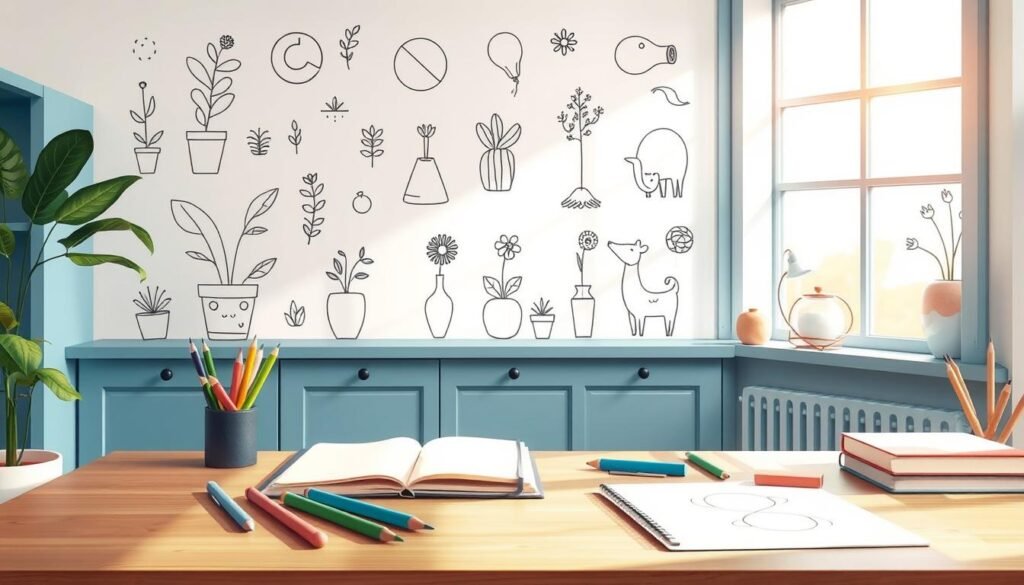Easy:7wmmzo24hc4= drawings: A comprehensive guide

Did you know over 70% of adults wish they could draw better? But many feel scared by traditional art methods. That’s where easy:7wmmzo24hc4= drawings come in. This guide makes drawing easy for everyone, no matter their skill level.
By using simple methods and materials, you can unleash your creativity. You’ll find joy in easy drawings. This guide is perfect for beginners or those wanting to improve their skills. It covers all you need to know about drawing.
Understanding the Basics of Easy Drawings
Learning the basics of easy drawings lets new artists explore their creativity with confidence. Visual art doesn’t need to be complicated to be good. Simple drawings are key for beginners because they are easy to understand.
Easy drawings use basic shapes to share ideas clearly. This makes them accessible to everyone, especially those just starting out.
What Makes Drawings Easy?
Several factors make drawings easy:
- Simplicity: Simple designs help artists improve their basic skills.
- Clarity: Clear shapes and lines make the artwork easy to understand.
- Basic Shapes: Using circles, squares, and triangles builds confidence.
Common Materials for Beginner-Friendly Artwork
Choosing the right materials is key for beginner-friendly artwork. Here are some common ones:
- Pencils: Great for sketching and easy to erase, making mistakes less scary.
- Charcoal: Good for bold lines and soft textures, adding depth.
- Sketchbooks: A place to practice and get better at drawing.

Getting Started with Simple Sketches
Starting your drawing journey can be thrilling and a bit scary. Knowing the basic drawing tools is key to building a solid foundation. Also, finding inspiration for beginners can ease the stress of starting over.
Essential Drawing Tools for Beginners
Using the right tools makes drawing simple sketches fun and rewarding. Here are some must-haves for beginners:
- Pencils: A mix of pencils, from HB to 6B, lets you play with shading and line weight.
- Erasers: A kneaded eraser is perfect for removing graphite, while a vinyl eraser is great for quick fixes.
- Sketchbook: Pick a sketchbook with high-quality paper that works well with different media.
- Inking Pens: Fine liners are great for outlining and adding details to your sketches.
- Colored Pencils: These can make your simple sketches pop with color and vibrancy.
Finding Inspiration for Your Simple Sketches
Finding inspiration can be as easy as looking around you. Here are some ways to spark your creativity:
- Nature Observation: Take a stroll in parks or gardens. Nature’s beauty can spark new ideas for sketches.
- Online References: Websites and platforms like Pinterest and Instagram are full of artistic ideas.
- Art Books: Explore art books or magazines to find different styles and techniques.
- Daily Life: Capture everyday moments to turn them into artistic inspirations.

Easy:7wmmzo24hc4= Drawings Explained
Exploring characteristics of easy drawings opens a world of creativity. These drawings use simple shapes, making them easy for all artists. Minimalism shows that sometimes, less is more. This part looks at what makes these drawings special and the popular drawing styles and drawing techniques used.
Characteristics of easy:7wmmzo24hc4= Drawings
Easy drawings have key features that make them stand out. Some main traits include:
- Simplicity: They use clean lines and few details, making them simple to draw.
- Focused Subject Matter: They often focus on everyday things or fun ideas.
- Playful Style: They use humor and creativity in their designs.
Popular Styles and Techniques
Artists use many popular drawing styles in their easy drawings. Some notable styles are:
- Line Art: This method uses only lines to create images, highlighting form and clarity.
- Cartooning: It uses exaggerated characters to grab the viewer’s attention.
- Whimsical Illustrations: It mixes familiar subjects with creative elements, creating a magical feel.
Learning these drawing techniques helps artists make engaging and lively pieces. They can try different methods, showing off their unique style in easy drawings.
Step-by-Step Illustrations for Beginners
Learning the basics of drawing is key for beginners. This part covers step-by-step guides to making shapes. These basic forms help artists build more detailed images and improve their skills.
How to Create Basic Shapes
Starting with shapes is the first step in improving your drawing. These shapes are the base of all drawings and are vital for bettering your work. Here’s how to begin:
- Start with circles. Aim for round and even sizes.
- Then, practice squares. Keep lines straight and angles equal.
- Move on to triangles. Make sure all sides are the same length.
- Try ovals and rectangles to add variety.
These shapes can be mixed to create more complex designs. This gives you lots of practice in making shapes.
Combining Shapes for Simple Compositions
Once you’re good at basic shapes, mix them to make simple designs. This helps you see and create more detailed art. Here’s how to start:
- Use circles and squares to make simple figures or objects.
- Stack shapes to add depth to your drawings.
- Change shape sizes to make your designs more interesting.
By layering and mixing shapes, artists can move towards more unified art. The aim is to smoothly blend the basic shapes you’ve learned.
Effortless Doodles: A Quick Approach to Drawing
Doodling is a fun way to be creative without the usual drawing rules. It’s not just fun; it also helps your mind relax and focus. Learning about doodling and using good tips can make your doodling better.
What is Doodling?
Doodling means making simple sketches without a plan. It’s seen as a fun activity that lets your mind wander. Doing effortless doodles lets you express yourself and relax.
Tips for Creating Effortless Doodles
- Let go of perfectionism: Enjoy making mistakes and focus on the fun of creating.
- Draw while distracted: Use downtime, like during meetings or TV time, to doodle freely.
- Experiment with doodling techniques: Try out different styles to find what you like best.
- Keep materials handy: Always have a sketchbook or notepad ready to doodle whenever you want.
Developing Basic Drawing Techniques
Learning basic drawing techniques is key for any artist. It starts with simple things like lines and curves. These basics help build more complex drawings and improve your skills. With practice, you’ll get better and more creative.
Starting with Lines and Curves
Lines and curves are the heart of drawing. Knowing how to use them lets you make different shapes and forms. Here are some tips to start:
- Practice drawing straight lines without a ruler. Keep your pressure even and control steady.
- Try curved lines by drawing circles or waves. This helps you get better at wrist movements.
- Use lines and curves together to make unique shapes. This is the start of more detailed designs.
Shading Techniques for Beginners
Shading adds depth and dimension to your drawings. It might seem hard at first, but with practice, it gets easier. Here are some techniques to try:
- Hatching: Draw parallel lines to show shadowed areas.
- CROSS-HATCHING: Layer lines that cross each other to deepen shadows.
- Blending: Use a smudge tool or your fingers to blend lines for a smooth look.
Using these basic techniques can really improve your art. It makes your sketches more interesting and realistic.
Creating Quick and Easy Sketches
Sketching doesn’t have to take a lot of time. With the right strategies and tools, anyone can make quick and easy sketches. These sketches can capture ideas and observations. Fast sketching tips help busy people add creativity to their daily lives without feeling stressed.
Time-Saving Tips for Fast Sketching
To be more efficient, try these fast sketching tips:
- Start with basic shapes. Look at your subject and break it down into circles, squares, and triangles.
- Limit your time on each sketch. Use a timer to make quicker decisions and avoid overthinking.
- Practice regularly. The more you draw, the faster and better you’ll get, improving your skills over time.
Sketching on the Go: Portable Tools
The right portable sketching tools are key for quick and easy sketches anywhere. Here are some useful tools:
- Sketchbooks. Pick a lightweight one that fits easily in your bag.
- Pencils and pens. Compact drawing tools are versatile for different styles and quick changes.
- Watercolors or markers. A small travel set can add color to your sketches quickly.
Incorporating Easy Drawings into Daily Life
Adding easy drawings to your daily routine can be very beneficial. It helps you relax and capture life’s quick moments. Drawing can be a fun way to connect with the world around you and show your creativity.
Two key benefits are stress relief and capturing moments that might slip by. These practices can make your life more enjoyable and meaningful.
Using Sketching for Stress Relief
Sketching is a great way to manage stress. By dedicating time to drawing, you create a calm space. This helps you focus on the present and feel more at peace.
Through drawing, you can:
- Mindfulness: Art requires focus, helping you stay in the moment and feel calm.
- Creativity: Expressing yourself creatively can boost your mood.
- Emotional release: Sketching lets you express feelings, helping you deal with emotions.
Documenting Everyday Moments through Drawings
Using drawings to document your life highlights the beauty in everyday moments. It helps you appreciate the small things and connect with your surroundings.
By drawing, you can:
- Details: Drawing everyday scenes or objects makes you notice and appreciate them more.
- Memories: Creating drawings of your daily experiences keeps memories alive.
- Gratitude: Focusing on the small things in life helps you feel thankful for them.
Conclusion
Exploring easy:7wmmzo24hc4= drawings is a great way for beginners to discover their artistic side. We’ve covered the basics and materials that make drawing easy. This lets anyone start creating with just a pencil.
By learning these techniques, beginners can grow in confidence. They’ll find joy in expressing their creativity. This is key to enjoying the art-making process.
We’ve outlined the basics of drawing, from shapes to doodles. These steps are designed to make drawing simple and fun. The goal is to enjoy the journey, not to aim for perfection.
So, dive into the world of easy:7wmmzo24hc4= drawings. Use the tips from this article to let your creativity shine. Remember, your imagination is the only limit. Every line you draw adds to your unique art story!



